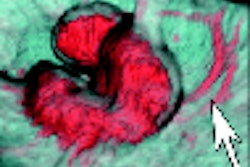As debate inches forward in the U.S. over the value of screening virtual colonoscopy, a radiologist in the Midwest has already arranged reimbursement with local payors, and built a thriving practice.
Judging from his recent editorial in Radiology, it would appear that Dr. Perry Pickhardt from the University of Wisconsin Medical School in Madison likes to think nationally and act locally. Even closer to home, the institutional level is where an individual radiologist can have the most impact in terms of establishing a VC program, according to Pickhardt.
Success depends on a healthy mix of ingredients, such as the ability to provide noninvasive yet effective colon screening, the ability to interweave VC into an already-established colonoscopy program, the ability to create a patient-friendly and seamless service, and if needed, the ability to receive third-party reimbursement for screening VC, he wrote in the editorial (Radiology, April 2005, Vol. 235:1, pp. 17-20).
"The factors necessary for success can occur at various levels," Pickhardt noted. "Broadly there is a national level at which the current hurdles of demonstrating uniform clinical efficacy and addressing the continued resistance to reimbursement dominate. The local level relates to the milieu of hospitals and third-party payors that shapes the regional healthcare environment. Finally, there is the institutional level, at which equipment, personnel, hospital administration support, and clinical colleague relationships are critical."
Nationally, the variability of VC results has left most national societies and professional groups, such as the Atlanta-based American Cancer Society, "unable to issue blanket statements in support of CT colonography screening," Pickhardt wrote. "Inconsistent clinical results are also reflected in health technology assessment reports from such groups as the Technology Evaluation Center of the Blue Cross/Blue Shield Association and the Hayes Technology Assessment Group, which continue to view CT colonography as investigational." As a result, he predicted that the U.S. Centers for Medicare and Medicaid Services (CMS) is unlikely to provide national financial coverage for the colorectal cancer screening procedure anytime soon.
To get their own program off the ground, Pickhardt and colleagues at the University of Wisconsin Medical School launched a more grassroots effort in Dane County, WI, which has a preponderance of locally owned managed care organizations (MCOs). Few residents are covered under traditional indemnity organizations, he explained, which leaves the MCOs free to make coverage decisions.
"The fundamental purpose of an MCO is to collect premiums from purchasers (i.e., employers, individuals, and the government) and to add value by providing management services so the purchaser can have either better or cheaper health outcomes for their premiums," Pickhardt wrote. Technology assessment plays a big role in this process, and was found to be favorable to the virtual colonoscopy technique used by Pickhardt and colleagues in their multicenter trial, which famously beat conventional colonoscopy among 1,192 asymptomatic patients (New England Journal of Medicine, December 4, 2003, Vol. 349:23, pp. 2191-2120).
Based on the study and a formal presentation by the author, one MCO signed on to give patients the choice between screening VC and conventional colonoscopy, and other payors have since joined the network.
"Despite the fact that coverage for an additional screening option would probably lead to greater resource use, it was determined that this was an excellent use of premium dollars," Pickhardt wrote. "There were additional factors that may have had some influence on these MCO coverage decisions. One factor was the long queue for screening optical colonoscopy, which was due to a combination of high local demand for screening and limited capacity. Another factor was the obvious need for increased patient compliance to colorectal cancer screening recommendations, particularly among those who were reluctant to undergo optical colonoscopy."
The very local level
At the institutional level, careful attention to seemingly unrelated details is needed to ensure successful implementation of a VC program, Pickhardt wrote. He recommended the use of a multidetector-row scanner, as well as "robust colon preparation," including tagging of any remaining fecal material and fluid. Finally, a biphasic approach to interpretation using advanced software that incorporates both 2D and 3D for polyp detection ("with an emphasis on the latter") can provide results comparable to those of conventional colonoscopy, Pickhardt wrote. (As it did for the NEJM study, the group continues to rely on the V3D software package by Viatronix of Stony Brook, NY, for interpretation.)
The VC program coordinator is the linchpin for setting up and running a successful practice, he wrote. A highly skilled CT technologist might be a good candidate for such a position. At his institution, however, a "highly motivated" registered nurse got the nod, with funding from both the hospital and the medical school, Pickhardt wrote. Strong communication skills are required to support frequent patient and referring physician interactions, and the nurse's training was helpful in understanding the medical issues involved in both colonoscopy and VC.
Incorporating VC into the existing screening armamentarium required the support of the gastroenterology department, which worked with radiology to determine program interaction and practice guidelines compatible with the facility's equipment and scheduling needs.
There was initial debate about polyp-size thresholds between the two departments, but everyone eventually agreed on the following criteria, which were approved by the institutional review board:
- Patients with polyps 10 mm or larger would be referred for optical colonoscopy.
- VC findings 5 mm or smaller would not be reported.
- Patients with polyps measuring 6-9 mm could opt for either polypectomy or short-term VC surveillance.
Although support from gastroenterology is helpful for establishing the service, it is important to remember that most screening VC referrals will come from primary care providers, Pickhardt wrote.
"It is this group of general practitioners that must ultimately appreciate the value of CT colonography for screening," Pickhardt wrote. "This can be achieved though a variety of means, including medical literature review, grand rounds presentations, local media attention, and general word of mouth. If you can build a service-friendly and reliable CT colonography clinical program that receives financial reimbursements from third-party payors, the patients will definitely come."
As of May 2005, the UW Hospital and Clinics examines approximately 150 patients a month with screening virtual colonoscopy, according to Pickhardt. Based on demand, even more patients could be screened, he added, but CT and radiologist staffing issues will need to be addressed first. Less than 1% of patients are paying out of pocket.
"The success of our VC screening program has greatly surpassed our initial expectations," Pickhardt wrote in an e-mail to AuntMinnie.com. "Satisfaction levels from our patients, gastroenterologists, and referring physicians remain very high. From a cost-effectiveness standpoint, our endoscopic referral rate is acceptably low (< 10%), and a matching lesion is found in well over 90% of cases sent to optical colonoscopy."
By Eric Barnes
AuntMinnie.com staff writer
May 10, 2005
Related Reading
Internal medicine doc finesses colon cancer screening guidelines, April 18, 2005
Primary care measures boost colorectal cancer screening, April 11, 2005
Men more likely to be screened for prostate cancer than colon cancer, March 8, 2005
VC gets long-awaited reporting standards, November 2, 2005
Copyright © 2005 AuntMinnie.com



















